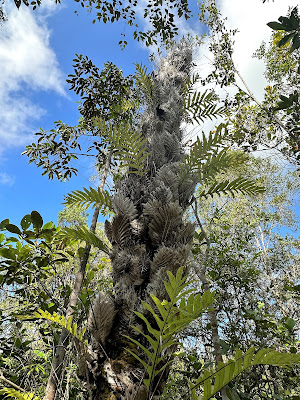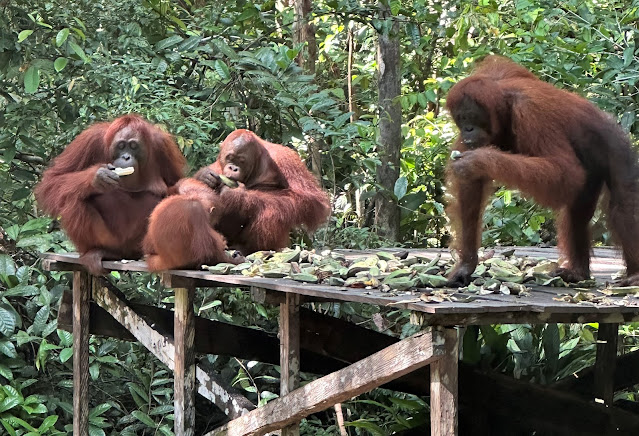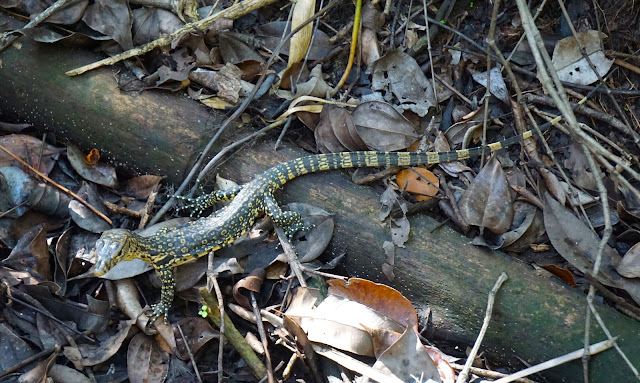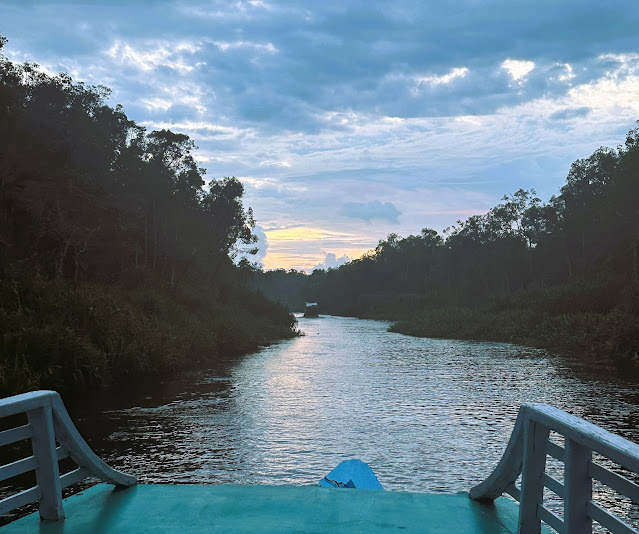July 6, 2023
We slept well (other than multiple trips to the bathroom due to the amount of water we imbibed in order to stay hydrated), and got up around 5:15. I took a freezing cold shower, only to learn from Bob after HIS shower that there was hot water. Darn! The power stayed on and I was able to blow dry my hair, a big event.We ate a breakfast of scrambled eggs (Bob) and a cheese omelet (me) with orange juice and the usual pineapple slices and toast with butter and jam. Bob coined the phrase: "Indonesia, where the butter is always soft!"
We were on the klotok by 6:30 and were, as far as we could tell, the first boat moving. We passed dozens of boats like ours with people just getting up or eating breakfast on the deck. The four-beat rhythm of our engine certainly disturbed the peace and would have awoken anyone who was still sleeping.
.
No two klotoks are the same. We enjoyed the variety.
We really loved our young, enthusiastic, and very friendly guide, Sam.
The water was almost perfectly smooth and mirrored the foliage lining the banks as well as the cloudy sky.
While we weren't seeing other boats moving, we did see a kingfisher and a red and black broadbill. We also saw three orangutans (one a baby with its mom), some proboscis monkeys, and some long-tailed macaques in the trees lining the river.
I've only realized since reviewing my photos that we had to LEAVE the national park every night to dock our boat. A welcome sign on our way back into the park showed evidence of U.S. support for the park. See the USAID symbol at the bottom right.
Our first stop was Pondok Tanggui, where we walked for about 20 minutes to an orangutan feeding station site.
Signage at the site informed us that:
- Orangutans are found only in tropical rain forests in Sumatra and Borneo.
- They primarily eat fruits, but can also eat bark strips, leaves, and termites.
- Unlike all of the other primates, they are solitary most of their lives.
- They are pregnant for 8 months and may wait 5-10 years between births.
- Young orangutans will stay with their mothers until they are 5-8 years old.
- They live 45-50 years in the wild
Sam had us stand off to the right side by the wood and rope barriers, where he said sometimes the orangutans enter the area. He pointed out a stream of termites walking along the rope. They were so thick that the rope looked black.
Workers dumped buckets of bananas on the raised deck, and not much later the orangutans began to show up. Look carefully and you'll see that the first one that arrives has a baby on her back. Sometimes the babies were hard to see because they blend in so well.
Suddenly, these orangutans climbed down from the platform and moved quickly into the jungle. (And by the way, it was always interesting and a bit startling to see them walking upright like humans.) What had startled them?
Monti did. She was a huge female that established her dominance as soon as she arrived, and the others were clearly afraid of her. Apparently she is a regular, and the rangers have named her Monti. She plopped down on the deck and ate and ate and ate. Sam told us she has cancer, but there is really nothing they can do about it, and it certainly hasn't affected her appetite.
The rangers kept calling out with a very loud hooting noise, a sound the orangutans know means "Come and eat!" More and more started to show up, and it was fun to watch their languorous progress through the trees.
The best moment was when a mama with a baby clutching onto her leaned in from one side of the deck, keeping one hand on a nearby tree and stretching in to reach the banana piles with her other hand, all the while keeping her eyes on Monti. She stuffed at least six bananas in her mouth and one or two in her baby's mouth, then snuck away. Make sure you watch the video to the end.
Another great moment was when a family of three came walking through a break in the fence right next to us (as predicted by Sam). That was pretty darn exciting.
These three didn't seem too disturbed by Monti. I guess there is safety in numbers.
We started back to our klotok, stopping to look at some cool red-spotted pitcher plants and some claw marks on a tree made by a sun bear.
Some long-tailed macaques were sitting on the edge of the long wood walkway that led back to the river or resting in the trees next to it. We took photos of several of them.
However, one of them developed an exceptional dislike of Bob. It leapt across the walkway right over Bob's head four times in a very threatening manner, hissing and baring its teeth each time and making Bob duck and cover his head with his arms. Sam said that Bob had looked the monkey in the eyes, which violates jungle etiquette. The monkey takes it as a challenge. In fact, later in the trip when we were in other places with monkeys, we saw signs that warned against looking them in the eyes!
Right before the dock there was an orangutan on the boardwalk. Sam told us he was a teenager (14-18 years old), and the rangers have named him Atlas.
He pretty much pretended there weren't twenty or so people staring at him, even posing for photos with him in the background. Guides kept everyone the requisite safe distance, but Atlas looked WAY too lazy to attack. In fact, at one point he just flopped down on the boardwalk for a morning nap.
Pondok Tanggui was a smaller station than the one we had seen the previous day or than the one we would see next, but with the sneaky mama stealing bananas, the three orangutans walking in right next to us, and Atlas the Lazy Orangutan, it had some of my favorite moments in Borneo.
Back on our klotok, we motored past some interesting structures. I assume they were the homes of some of the people who work in the area, but I'm not sure. (Not everyone works in tourism. For example, supposedly there is a lot of illegal mining going on, which is partly responsible for the muddy water.)
Lunch was another culinary extravaganza of rice, fried shrimp, steamed veggies, fried eggs in tomato sauce, corn cakes, and chunks of papaya so mild even someone like me who doesn't like papaya could enjoy them.
Further up the river, the water is black rather than muddy brown because of tannins that are released from decaying plants. Supposedly the black water is cleaner than the polluted brown water we had been traveling on so far.
We saw yet another kind of pitcher plant on our walk through the camp. These were shaped like bean pods.
We also saw a thick line of fire ants carrying off the body of a large centipede.
When we got to the Camp Leakey feeding station, a gibbon was just arriving in a series of Evel Knievel-style leaps between trees, maybe as much as 12 feet in distance, and one after another. Sam told us this gibbon hangs around the feeding station, and the rangers have named him BOB!
Bob sat in a tree above the deck for almost 30 minutes until the bananas and some big bowls of milk were set out, and then he was the first one down for a quick shoplifting visit, completed while the staff member was still on the deck spreading out the bananas and filling tin pans with milk. He wasn't afraid of the human, and the human paid no attention to him.
Watching the great apes arrive never got old. This station is the only one that provides milk--I'm not sure why--and it was fun to see the mama orangutan drink.
"Junior, do I have to come down there and GET you? Junior? Junior! I'm telling your father about this!"
This time there was a definite alpha male (named Jacob by the staff) who plopped down on one end of the deck and methodically stuffed his face. This is not a creature I'd want to make mad.
A mother with a newborn clutching the fur on her back walked in right next to me, stopping 2-3 times as if she were either posing for photos or showing off her cute baby.
It was all wonderful, but it was mid-afternoon and it was SO HOT. We would have stayed longer, but we were melting away. Were it not for the fans Sam had provided the day before, I don't think we would have made it.
On our way back to our klotok, Sam pointed out what looked like a stick covered in white flowers, but they were actually insects!


.JPG)
.JPG)





.JPG)
.JPG)
.JPG)



.JPG)

.JPG)
.JPG)






.JPG)
.JPG)




.JPG)



.JPG)
.JPG)

















As I look back, I like Tanjung Puting more and more. It was very hot and muggy, but the boat and its constant moving provided shade and a breeze. The food on the boat was very good and our guide, Sam, was very pleasant and easy to be around. If I were to go back, and I know you've said, never again, I would like to do a more focused boat ride on birds and monkeys and less focus on orangutans. Great post.
ReplyDelete